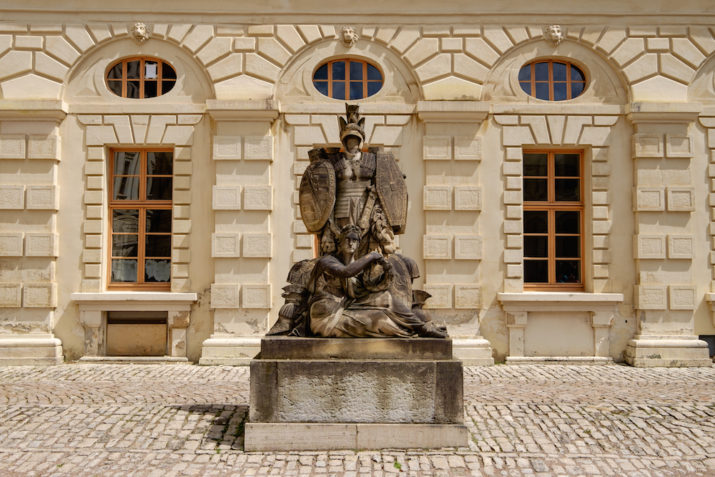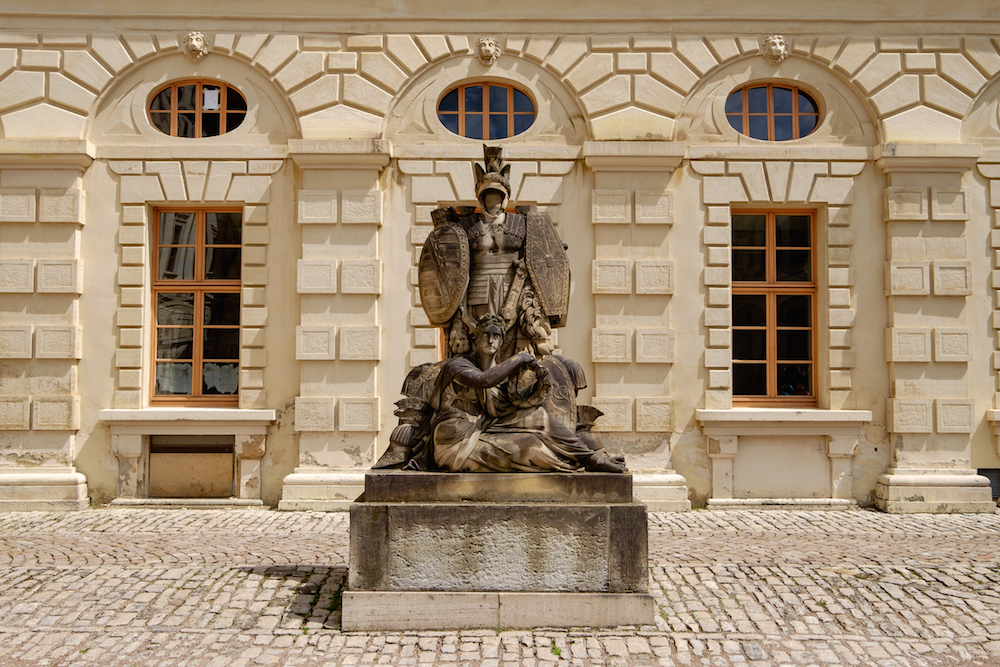

The year 2017 marked the 500th anniversary of the beginning of the Lutheran Reformation. The focus was on Wittenberg, where Martin Luther on October 31, 1517, allegedly posted his ninety-five theses against indulgences on the door of the church of Wittenberg Castle.
However, important steps towards reforming church and society were already being made in Weimar, where Duke Johann, the brother of Prince Frederik the Wise, resided after the two brothers had divided the ruling competences while maintaining one territory (Mutschierung).[1] Johann fostered the nascent reformation by supporting not only Luther but several other theologians and was authentically interested in their theological ideas.
Yet, it was Martin Luther who made a key contribution to the handling of the political consequences of the reformation. On October 24 and 25, 1522, he preached in the newly renovated church of the castle on worldly and ecclesiastical authority. The first part of his influential treatise “On Worldly Authority,” published in 1523, was based on these sermons. This was an extraordinary occasion. Since the Diet of Worms in 1521, Luther was officially banned by the emperor and lived hidden in the Wartburg castle. Thus, a banned monk preached in front of the princely family, which was legally obliged to turn him over to the emperor. The event was not only theologically decisive but politically significant. It showed that the leading Protestant principality was no longer willing to submit in religious matters to the emperor of the Holy Roman Empire of the German Nation and in turn used this case to gain more independence.
Luther delineated his “Two Kingdoms Doctrine” as a basic political theory for the emerging Protestant territories. On the one hand, he insisted in his first sermon that the church should not hold any worldly authority. He saw in the practice of his time that the pope and certain bishops were simultaneously acting as worldly princes and held worldly power, an aberration from the Holy Scripture and Christian teaching. For him, this was no less than the work of the devil. In matters of faith, the only legitimate power was the power of the word, not of the sword.
On the other hand, he also argued in his second sermon that worldly authority had the function and duty of being the steward for justice and peace in society by upholding the secular law, which he saw as derived from the second table of the Ten Commandments as a kind of divine natural law. Yet, the worldly authority – according to Luther in these sermons and his related publications – should not interfere in spiritual affairs, neither with regard to individual faith nor in church business. At the same time, it was the duty of the prince to protect the church, but not to interfere with its operations. This separation of worldly and ecclesiastical authorities is a nearly revolutionary idea against the background of the medieval concepts of the unity of Christendom, the idea of the superiority of the Pope in the Holy Empire, and the Two Swords Doctrine.[2]
Even though Luther’s concept was not fully realized when the Protestant principalities were organized, this distinction was one of the sources that facilitated the later development of the modern secular state. Combined with his theological teaching that individual faith is at least as important as the performance of priestly administered rituals of the church, Luther had sown the seeds for modern individualism and eventually equality. Nota bene, I am not claiming here, that the (Lutheran) reformation immediately realized these ideas – unfortunately it did not – nor do I claim that it was the only root, but it was one trigger for certain political, religious, and cultural developments, which were necessary conditions for and contributed to the development of the modern state and the ideas of individuality and equality. In fact, the latter often had politically to be struggled for against the church(es).
When Johann’s brother, Prince Frederik the Wise, died in 1525 and Johann had to succeed him and move to Torgau and Wittenberg, the prince’s main residences, he officially installed the reformation in August, 1525, in Weimar. He wanted to organize church affairs after the Peasant’s War before he left the Thuringian territory.
The church-state system he created basically comprised two areas: the relation between church and state and the reordering of the welfare system, the latter of which was until then run by the monasteries and churches.
Let’s turn to the first topic. The teachings of the reformation having been introduced officially in August, the services and the church organization were reformed accordingly. Church ministers and public servants were committed to the new faith on August 17 in front of the Weimar castle. Accordingly, a special branch of state government was installed which supervised the introduction of the teachings and structures of the reformation throughout the dukedom.[3]
Even though this was basically the opposite of what Martin Luther had intended three years before at the same place, a pattern was established which would soon become the model of the Lutheran/Protestant state churches that were developed in Central and Northern Europe. This was one important root of the development of the modern state in Europe: the state government was liberated from the control of the church. Even though an essentially Lutheran State Church was established, as was already mentioned, structurally this development contributed to the separation of church and state that allowed for the development of the modern secular state.
In the wake of reorganizing the institutional structure of the church, it was necessary to restructure the welfare system as well. During the Peasants’ War many monasteries had been destroyed and the monks expelled or even worse. In the immediate aftermath, the financial structures of the monasteries and hospices were in turmoil. The prince tried to reorder things and to bring the income under his control. By the formal establishment of the teachings of the reformation as official doctrine, the Roman Catholic institutional structure and hierarchy was disbanded. As a result of these developments, the structure and funding of the care for the poor and sick disappeared.
Therefore, on August 24, 1525, Duke Johann established the Communal Box. The income of the former ecclesiastic foundations and benefices went into this new institution in order to finance the pastors, the church buildings, the schools and teachers, as well as welfare for the needy. In addition, the offerings of the church services and voluntary donations also went into the Communal Box.
This invention was not totally new. In other places, the problem of reorganizing the funding of the churches, the schools and the welfare system had been solved in a similar manner. But with the decree of Duke Johann, the system of the Communal Box was established officially for a whole territory and thus became the model for most of the evangelical territories, which could no longer rely on the social system of the Roman Catholic church. With the “visitations” of the following years, the Prince not only made sure that the services and teachings were conducted according to the doctrine of the reformation, but also controlled the establishment of Communal Boxes throughout his territory.[4]
Most interestingly, the Communal Box was placed under the supervision of the local political authorities. This is quite significant, even if we take into account that political and ecclesiastical communities were mostly identical in their membership, since there was no religious plurality and the idea of non-affiliation was not very popular. Although, the clergy were included in the bodies controlling the Communal Box, it was the City Council which exercised final authority over spending from the Communal Box.
The pattern that the government is responsible for the welfare (system), typical of the Central and Northern European states that were traditionally predominantly Lutheran, can be traced to this root. It was in line with the condemnation of begging and the emphasis on work as a religiously motivated calling. Recent social research shows that these patterns were efficient from a long-term perspective, and that differences in the social cultures between the Northern and Central European Lutheran, the Western and Southern European predominantly Catholic states, and the more reformed Anglo-Saxon world can be explained by these factors.[5] For Germany a development path was chosen which led to the public social security system created by Chancellor Bismarck in order to contain socialist influences among the working class. Later, the Weimar Reich Constitution also included certain social rights (connected with the family).
With both areas connected with the official establishment of the Reformation, the prince expanded his power and united several layers of ruling in his control. In addition to the political, juridical, and economic power he already held and increasingly centralized in his territory, the power over the religious and welfare institutions was set under central control. This was an important step in the development of the modern state with an integrated territory and unified government.
The welfare system of the Communal Box already came under pressure in the aftermath of the Thirty Years’ War finally broke down during the Napoleonic Wars[6] to be eventually replaced by Bismarck’s social security system in the 1880s. However, the model of the Church-State relationship remained in place basically until the revolutions in November, 1918, when the aristocratic rule was abolished throughout the German Empire. It was then replaced by the so-called “limping separation” of church and state in the Weimar Reich Constitution in the summer of 1919. It is called “limping separation” since the Protestant church was not a state church any more. Yet, the established religious bodies were given certain privileges under the constitution (religious education in public schools, the right of taxation etc.) which established a dialectic of formal separation and close cooperation.
Though Weimar was never the capital of Germany, two decisive developments in German political history took place here. First, the formal establishment of the Reformation in Weimar in August, 1525, marked the beginning of a new church-state relationship, which lasted several centuries and contributed to the development of the modern state. Second, the replacement of this model by the Weimar Reich Constitution in Weimar in the summer of 1919[7] established for the first time not only the democratic self-rule in Germany, but also opened the doors for the development of a religiously and culturally plural society. This development was brutally interrupted by two dictatorial systems, National Socialism and Communism, as different as they are. Yet, a unified and democratic Germany was not only able to celebrate the 500th anniversary of the Reformation in 2017 but also will celebrate the 100th anniversary of the first German democracy in Weimar.
Michael Haspel is director of the Protestant Academy of Thuringia and extraordinary professor for Systematic Theology at the Friedrich-Schiller-University Jena. He studied protestant theology, rhetoric and public law in Tübingen, Bonn and Harvard, received a master of Theology from the Harvard Divinity School and a Ph.D. in theology from the University of Marburg. His emphasis is on social ethics. He was guest lecturer at Stellenbosch University, South Africa and the University of Tartu, Estonia. Selected bibliography (books are in German; titles translated): Political Protestantism and Social Transformation. A Comparison of the protestant church in the GDR and the black church in the civil rights movement in the USA, Tübingen/Basel 1997. With Britta Waldschmidt-Nelson (Eds.): Martin Luther King. Life, Work, and Legacy. Weimar 2008. Social Ethics in Global Society. Foundations and Orientation from a Protestant Perspective Stuttgart 2011.
Photo: Statue in the castle of Weimar/Germany
References:
[1] For the history of the Weimar castle as residence of the princely court see Gerhard Müller, “Das Weimarer Schloss als historischer Ort der Reformation”, in Weimar und die Reformation. Luthers Obrigkeitslehre und ihre Wirkungen, ed. Christopher Spehr, Michael Haspel and Wolfgang Holler (Leipzig: Evangelische Verlagsanstalt, 2016), 31–43. Dagmar Blaha,“Die Struktur des Weimarer Hofes unter Herzog Johann von Sachsen“, in, op. cit. 44–58.
[2] Fort the sermons see Christopher Spehr, “Luthers Weimarer Obrigkeitspredigten im Jahr 1522“, 13–30, in Weimar und die Reformation. Luthers Obrigkeitslehre und ihre Wirkungen, ed. ibid., Michael Haspel and Wolfgang Holler (Leipzig: Evangelische Verlagsanstalt, 2016). For the Two Kingdoms Doctrine see Svend Andersen, Macht aus Liebe: Zur Rekonstruktion einer lutherischen politischen Ethik (Berlin: De Gruyter, 2010. Volker Stümke, Das Friedenverständnis Martin Luthers: Grundlagen und Anwendungsbereiche seiner politischen Ethik (Stuttgart: Kohlhammer, 2007).
[3] Cf. Joachim Bauer, Die Reformation in Thüringen (Erfurt: Thüringen – Blätter zur Landeskunde, 1992). Ibid.,“Reformation und ernestinischer Territorialstaat in Thüringen“, in Thüringische Kleinstaaten und Kultur 1500–1920, ed. Jürgen John (Weimar: Böhlau, 1994), 3773. Ibid.,“Die “Weimarer Reformation“ unter Johann dem Beständigen: Ihre Bedeutung für die reformatorische und gesellschaftliche Neuordnung in Kursachsen“, in Weimar und die Reformation. Luthers Obrigkeitslehre und ihre Wirkungen, ed. Christopher Spehr, Michael Haspel and Wolfgang Holler (Leipzig: Evangelische Verlagsanstalt, 2016), 59–82.
[4] Joachim Bauer, [Dagmar Blaha], “Gemeine Kästen in Kursachsen 1525–1531“, in Jahrbuch für Geschichte des Feudalismus, vol. 12 (Berlin: Akademie Verlag, 1989), 207–77.
[5] Cf. Sigrun Kahl, ”The Religious Roots of Modern Poverty Policy. Catholic, Lutheran, and Reformed Protestant Traditions compared”, in European Journal of Sociology, vol. 46 (1), 2005, 91–126.
[6] Cf. Michael Haspel, Johannes Falks Werk als Impuls für eine zivilgesellschaftlich verantwortete Sozial-staatlichkeit aus evangelischer Verantwortung“, in Johannes Daniel Falks Impulse für Sozialpädagogik, Diakonie und Sozialpolitik (Scripturae, vol. 5), ed. ibid., Ralf Koerrenz, (Weimar: Wartburg Verlag, 2016), 195–218. Ibid., “Der Protestantismus und die Soziale Frage: Die Geburt der Diakonie aus dem Geist der Sozialdisziplinierung“, in Armut und Armenfürsorge. Protestantische Perspektiven (=Kultur und Bildung, vol. 5), ed. Ralf Koerrenz, Benjamin Bunk (Paderborn: Ferdinand Schoeningh, 2014), 119–34.
[7] Cf. Herbert, Ulrich, Geschichte Deutschlands im 20. Jahrhundert (München: C.H. Beck, 2014), 177–222. Heinrich August Winkler, Der lange Weg nach Westen. Deutsche Geschichte 1. Vom Ende des Alten Reiches bis zum Untergang der Weimarer Republik (München: paperback, 2014 (2000)).
Published on April 17, 2018.




